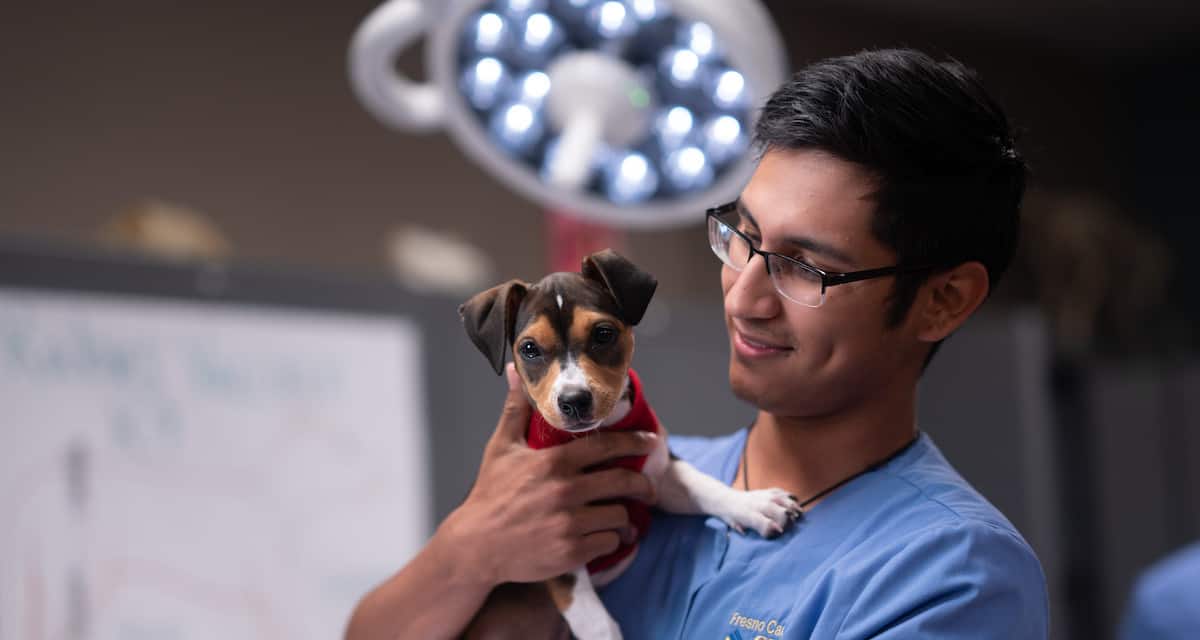What’s the Difference between a Veterinary Assistant and a Veterinary Technician?

Editor’s Note: This article was edited on November 9, 2021 to include updated BLS data.
What’s the Difference between a Veterinary Assistant and a Veterinary Technician?
We’ll take a closer look in the article below, but we do know that they both share one important similarity – a love of animals. If you’ve thought about pursuing a career that involves caring for animals then take a closer look at these two rewarding careers. See which seems right for you and explore what the pay and job outlooks are for each profession.
One major difference in these careers is that a veterinary technician works under the supervision of a licensed veterinarian and must pass a credentialing exam. Veterinary assistants work with the veterinarian or veterinary technician and do not need to pass a credentialing exam1.
According to the American Veterinary Medical Association, veterinary assistants support the veterinarian and/or the veterinary technician with their daily tasks. The assistant performs kennel work, assists in the restraint and handling of animals, feeds and exercises the animals, or spends time on clerical duties2.
CareerOneStop states that a veterinary technician’s tasks include performing medical tests in a laboratory environment for use in the treatment and diagnosis of diseases in animals. They prepare vaccines, take tissue and blood samples, and execute laboratory tests, such as urinalysis and blood counts. Duties also include cleaning, sterilizing and maintaining instruments and materials. They can also assist a veterinarian during surgery3.
Now, let’s take a look at their educational requirements.
Veterinary Assistant vs Veterinary Technicians: Education and Licensing
A veterinary assistant program typically results in a Certificate of Completion and includes an internship in an animal care facility. Certification is not mandatory for veterinary assistants, but it does allow workers to demonstrate competency in animal husbandry, health and welfare, and facility administration4.
Veterinary technicians must complete a 2-year associate’s degree in a veterinary technology program. Typically, technicians must also pass a credentialing exam to become registered, licensed, or certified, depending on the requirements of the state in which they work5.
But what Exactly do Veterinary Assistants and Veterinary Technicians Do?
Veterinary assistants and laboratory animal caretakers handle routine animal care and help veterinarians, and veterinary technologists and technicians with their daily tasks. They typically do the following6:
- Feed, bathe and exercise animals
- Restrain animals during examination and laboratory procedures
- Monitor and care for animals after surgery
- Give medication or immunizations that veterinarians prescribe
- Clean and disinfect cages, kennels, and examination and operating rooms
Veterinary technologists and technicians, supervised by licensed veterinarians, do medical tests that help diagnose an animals’ injuries and illnesses. Typical duties include7:
- Provide nursing care or emergency first aid to recovering or injured animals
- Restrain animals during exams or procedures
- Administer anesthesia to animals and monitor their responses
- Administer medications, vaccines, and treatments prescribed by a veterinarian
- Take x rays and collect and perform laboratory tests, such as urinalyses and blood counts
- Prepare animals and instruments for surgery
Are These Jobs in Demand in California?
If you want to train to become a veterinary assistant in California, check this out:
California has the highest level of employment of veterinary assistants and laboratory animal caretakers out of all the states in the U.S., coming in at 13,040 employed vet assistants and laboratory animal caretakers from a May 2020 report8. Veterinary technologists and technicians held about 8,950 jobs9.
The Bureau of Labor Statistics, U.S. Department of Labor, Occupational Outlook Handbook projects a roughly 14 percent increase in the need for both veterinary assistants and laboratory animal caretakers and a 15 percent increase in the need for veterinary technologists and technicians in between 2020 and 203010.
Increased pet-related spending is expected to drive employment in the veterinary services industry, which employs most veterinary assistants and laboratory animal caretakers. Demand for veterinary assistants and technicians will continue as the demand for these procedures increase11.
Veterinary assistants and laboratory animal caretakers and veterinary technologists and technicians overwhelmingly work in private clinics and animal hospitals. They also may work in laboratories, colleges and universities, and humane societies12.
How Much do Veterinary Assistants and Veterinary Technicians Make in California?
The mean annual wage for a veterinary assistants and laboratory animal caretakers in California was $35,620 in May 202013. Veterinary technologists and technicians earned even more with wages reported at $47,58014.
Next Steps
If you’re interested in a rewarding career path in California, becoming a Veterinary Assistant or Veterinary Technician offers good pay without having to earn a four-year degree.
San Joaquin Valley College offers a Veterinary Assistant program that results in a Certificate of Completion and a Veterinary Technology program that results in an Associate of Science degree. To learn more about these programs, contact San Joaquin Valley College at 866-544-7898. Request more information to get started!
1 www.avma.org/resources/pet-owners/yourvet/veterinary-technicians-and-veterinary-assistants
2 www.avma.org/resources/pet-owners/yourvet/veterinary-technicians-and-veterinary-assistants
3 www.careeronestop.org/Toolkit/Careers/Occupations/occupation-profile.aspx
4 www.bls.gov/ooh/healthcare/veterinary-assistants-and-laboratory-animal-caretakers.htm#tab-4
5 www.bls.gov/ooh/healthcare/veterinary-technologists-and-technicians.htm#tab-4
6 www.bls.gov/ooh/healthcare/veterinary-assistants-and-laboratory-animal-caretakers.htm#tab-2
7 www.bls.gov/ooh/healthcare/veterinary-technologists-and-technicians.htm#tab-2
8 www.bls.gov/oes/current/oes319096.htm#st
9 www.bls.gov/oes/current/oes292056.htm#st
10 www.bls.gov/ooh/healthcare/veterinary-assistants-and-laboratory-animal-caretakers.htm#tab-6
www.bls.gov/ooh/healthcare/veterinary-technologists-and-technicians.htm#tab-6
11 www.bls.gov/ooh/healthcare/veterinary-assistants-and-laboratory-animal-caretakers.htm#tab-6
12 www.bls.gov/ooh/healthcare/veterinary-assistants-and-laboratory-animal-caretakers.htm#tab-3
www.bls.gov/ooh/healthcare/veterinary-technologists-and-technicians.htm#tab-3
You might also like
More stories about
Request Information
All fields using an asterik (*) are required.


